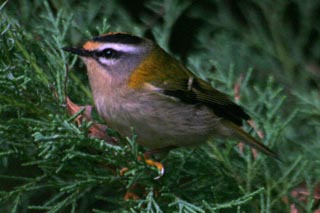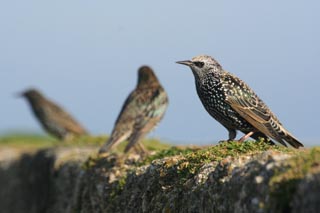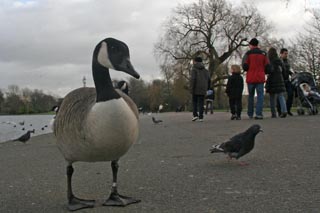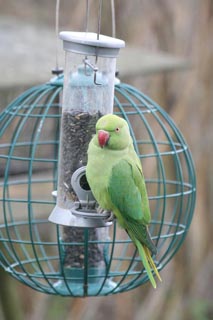 How many of you took part in the RSPB’s Big Garden Birdwatch on 28th/29th January? A gold star to those with their hands raised, and congratulations on being part of a huge group of budding surveyors. In 2011 over 600,000 people took part, counting more than 10 million birds! For those who didn’t, or those with no idea what I’m on about, let me explain.
How many of you took part in the RSPB’s Big Garden Birdwatch on 28th/29th January? A gold star to those with their hands raised, and congratulations on being part of a huge group of budding surveyors. In 2011 over 600,000 people took part, counting more than 10 million birds! For those who didn’t, or those with no idea what I’m on about, let me explain.
The Big Garden Birdwatch is an annual simultaneous survey by members of the public to count, for just one hour, the birds that they see in their garden. You don’t need to be an expert, nor, as the name might imply, do you need a big garden! In fact, you don’t need a garden at all since the survey also records results from local parks. All it takes is one hour of your time and the ability to count. Binoculars and cups of tea are useful but not essential, and the RSPB website contains handy identification charts for those who lack a guide book.
The survey has been running for over 30 years, and is now the largest wildlife survey in the world. In that time we have been able to document the decline of some of our more familiar species, and watch as others rise up the ‘top ten’ list from year to year. We know from the results that starlings and house sparrows have declined significantly, while long-tailed tits and some gull species are moving up the list. This may represent an increased awareness on the part of your good selves, the monitoring team, when it comes to knowing what’s about.
 I must confess that, in researching this article, I was disappointed to see that the firecrest I saw in my garden last year did not feature anywhere in the results. I even wondered whether I may have been the only person in the UK to report a firecrest. This seems unlikely, but I can tell you that there were not enough records for it to break into the top 72 species! A cunning piece of basic statistical analysis shows that the skylark, ranked at 72, was seen in 0.02{c8c3b3d140ed11cb7662417ff7b2dc686ffa9c2daf0848ac14f76e68f36d0c20} of gardens, which equates to around 6000 gardens in all. So there could in fact have been, at most, 5998 other firecrest sightings to accompany mine!
I must confess that, in researching this article, I was disappointed to see that the firecrest I saw in my garden last year did not feature anywhere in the results. I even wondered whether I may have been the only person in the UK to report a firecrest. This seems unlikely, but I can tell you that there were not enough records for it to break into the top 72 species! A cunning piece of basic statistical analysis shows that the skylark, ranked at 72, was seen in 0.02{c8c3b3d140ed11cb7662417ff7b2dc686ffa9c2daf0848ac14f76e68f36d0c20} of gardens, which equates to around 6000 gardens in all. So there could in fact have been, at most, 5998 other firecrest sightings to accompany mine!
But here I have fallen into the classic trap of wanting to see something rare and exciting. Those who have taken part will know the disappointment of seeing the same dunnock for the umpteenth time, and the inner demons coercing you into submitting just one or two extra sparrows than you actually saw. And you’ll also know the excitement of seeing something ‘new’ arrive, or being able to count that third chaffinch because this one was a male, and the other two were not! Whether your garden consists of nothing more than a slab of concrete, or is a bustling wildlife haven, the results are equally useful. And it just goes to show that there is something for us to see wherever we live, even if it is only the local magpie.
 I recently had the dubious pleasure of leaving the Roseland for new, more urban dwellings. And while I miss the beauty and charm of rural life, I am sufficiently drawn to the trappings of city living to be enjoying the novelty of it all. Now that I am closer to the big smoke, I found myself in London last weekend visiting friends and spending a small fortune. I appreciate that my financial misgivings are no concern of yours, but I tell you this because I was joyfully ignorant of quite how much the city can offer for naturalists. On a fine Sunday morning we promenaded through Regent’s Park and my companion, a non-birder, was treated to a veritable banquet of sightings. These ranged from the obvious (mallard, mute swan, coot) and the captive (mandarin and wood duck, Egyptian goose), to the wild (sparrowhawk, long-tailed tit, great crested grebe) and the feral (Canada goose, ring-necked parakeet).
I recently had the dubious pleasure of leaving the Roseland for new, more urban dwellings. And while I miss the beauty and charm of rural life, I am sufficiently drawn to the trappings of city living to be enjoying the novelty of it all. Now that I am closer to the big smoke, I found myself in London last weekend visiting friends and spending a small fortune. I appreciate that my financial misgivings are no concern of yours, but I tell you this because I was joyfully ignorant of quite how much the city can offer for naturalists. On a fine Sunday morning we promenaded through Regent’s Park and my companion, a non-birder, was treated to a veritable banquet of sightings. These ranged from the obvious (mallard, mute swan, coot) and the captive (mandarin and wood duck, Egyptian goose), to the wild (sparrowhawk, long-tailed tit, great crested grebe) and the feral (Canada goose, ring-necked parakeet).
 For someone with little knowledge of the conservation status of these species (I am referring to my friend in this instance) the sheer variety of colour, shape and form was overwhelming. And I was not underwhelmed by it all myself! (Incidentally, is it possible to be simply whelmed?). Though I don’t suppose my friend will be taking out an RSPB membership and purchasing binoculars anytime soon, she was at least able to remember a few more bird names by the following day. And more comical yet was the fact that, in trying to take a ground level photo of a Canada goose, I inadvertently captured a passing Joe Cole, of England International Football Team fame, in the background!
For someone with little knowledge of the conservation status of these species (I am referring to my friend in this instance) the sheer variety of colour, shape and form was overwhelming. And I was not underwhelmed by it all myself! (Incidentally, is it possible to be simply whelmed?). Though I don’t suppose my friend will be taking out an RSPB membership and purchasing binoculars anytime soon, she was at least able to remember a few more bird names by the following day. And more comical yet was the fact that, in trying to take a ground level photo of a Canada goose, I inadvertently captured a passing Joe Cole, of England International Football Team fame, in the background!
I fear at this point that I may have let enthusiasm reign at the expense of clarity, so I shall return to the point. All of this is out there for you to experience, whether you hail from the concrete jungle, central suburbia or rural habitation. In fact, for those of you lucky enough to live on the Roseland, might I recommend a short holiday to somewhere more urban?! And though it may be too late for any contributions to the Big Garden Birdwatch, I suggest you take some time, perhaps just one hour, to advance your own experience. And when you do, give yourself a gold star!
